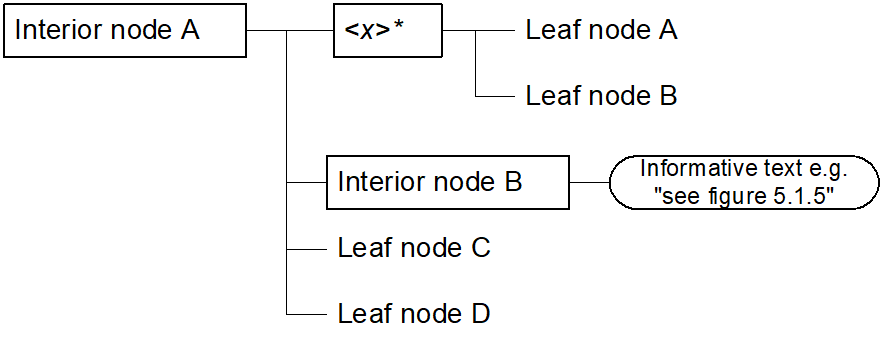Content for TS 24.483 Word version: 18.0.1
1 Scope
2 References
3 Definitions and abbreviations
3.1 Definitions
3.2 Abbreviations
3.3 Symbols
3.4 Management Object design and representation guidelines
...
...
1 Scope p. 43
The present document defines a number of Mission Critical Services (MCSs) Management Objects (MO) that are configured for the UE for the operation of MCSs. The management objects are compatible with OMA Device Management protocol specifications, version 1.2 and upwards, and is defined using the OMA DM Device Description Framework as described in the Enabler Release Definition OMA OMA-ERELD_DM-V1_2 [2].
MCSs are services that require preferential handling compared to normal telecommunication services, e.g. in support of police or fire brigade.
MCSs can be used for public safety applications and also for general commercial applications (e.g., utility companies and railways).
The present document is applicable to an UE supporting on-line, off-line or both on-line and off-line configuration of the configuration management client.
The present document is applicable to an UE supporting off-line configuration of the group management client.
The parameters defined by the management objects in the present document are configured in the UE using on-line configuration over the CSC-4 reference point and using off-line configuration over the CSC-11 and CSC-12 reference points. Other specifications define how these parameters are used in the operation of MCSs, and whether they are applicable to on-network operation or off-network operation, or both:
- 3GPP TS 24.379;
- 3GPP TS 24.380;
- 3GPP TS 24.481;
- 3GPP TS 24.482;
- 3GPP TS 24.484;
- 3GPP TS 24.282;
- 3GPP TS 24.582;
- 3GPP TS 24.281; and
- 3GPP TS 24.581.
- MCPTT UE configuration MO;
- MCPTT user profile MO;
- MCS group configuration MO;
- MCPTT service configuration MO;
- MCS UE initial configuration MO;
- MCData UE configuration MO;
- MCData user profile MO;
- MCData service configuration MO;
- MCVideo UE configuration MO;
- MCVideo user profile MO; and
- MCVideo service configuration MO.
2 References p. 44
The following documents contain provisions which, through reference in this text, constitute provisions of the present document.
- References are either specific (identified by date of publication, edition number, version number, etc.) or non-specific.
- For a specific reference, subsequent revisions do not apply.
- For a non-specific reference, the latest version applies. In the case of a reference to a 3GPP document (including a GSM document), a non-specific reference implicitly refers to the latest version of that document in the same Release as the present document.
[1]
TR 21.905: "Vocabulary for 3GPP Specifications".
[2]
OMA OMA-ERELD-DM-V1_2-20070209-A: "Enabler Release Definition for OMA Device Management, Version 1.2".
[3]
OMA OMA-TS-DM_Protocol-V1_2: "OMA Device Management Protocol".
[4]
OMA OMA-TS-XDM_Group-V1_1-20120403-A: "Group XDM Specification".
[5]
TS 23.003: "Numbering, addressing and identification".
[6]
TS 23.303: "Proximity-based Services (ProSe); Stage 2".
[7]
TS 24.379: "Mission Critical Push To Talk (MCPTT) call control Protocol specification".
[8]
TS 24.380: "Mission Critical Push To Talk (MCPTT) media plane control Protocol specification".
[9]
TS 24.481: "Mission Critical Services (MCS) group management Protocol specification".
[10]
TS 31.102: "Characteristics of the USIM Application".
[11]
TS 24.482: "Mission Critical Services (MCS) identity management Protocol specification".
[12]
TS 24.484: "Mission Critical Services (MCS) configuration management Protocol specification".
[13]
RFC 4566 (July 2006): "Session Description Protocol".
[14] Void.
[15]
TS 23.179: "Functional architecture and information flows to support mission critical communication services; Stage 2".
[16]
TS 24.282: "Mission Critical Data (MCData) signalling control Protocol specification".
[17]
TS 24.582: "Mission Critical Data (MCData) media plane control Protocol specification".
[18]
TS 24.281: "Mission Critical Video (MCVideo) signalling control Protocol specification".
[19]
TS 24.581: "Mission Critical Video (MCVideo) media plane control Protocol specification".
[20]
TS 33.180: "Security of the mission critical service".
[21]
TS 23.032: "Universal Geographical Area Description (GAD)".
[22]
OMA OMA-TS-DM_StdObj-V1_2-20070209-A: "OMA Device Management Standardized Objects", http://www.openmobilealliance.org/release/DM/V1_2-20070209-A/OMA-TS-DM_StdObj-V1_2-20070209-A.pdf .
[23]
TS 23.501: "System Architecture for the 5G System; Stage 2".
[24]
RFC 3748 (June 2004): "Extensible Authentication Protocol (EAP)".
3 Definitions and abbreviations p. 45
3.1 Definitions p. 45
For the purpose of the present document, the following terms and definitions given in TS 23.179 apply:
Pre-selected MCPTT user profile
3.2 Abbreviations p. 45
For the purposes of the present document, the abbreviations given in TR 21.905 and the following apply. An abbreviation defined in the present document takes precedence over the definition of the same abbreviation, if any, in TR 21.905.
5GS
5G System
ACL
Access Control List
APN
Access Point Name
CMS
Configuration Management Server
DDF
Device Description Framework
DM
Device Management
DNN
Data Network Name
EPS
Evolved Packet System
GMS
Group Management Server
MCS
Mission Critical Service
MCSs
Mission Critical Services
MCPTT
Mission Critical Push To Talk
ME
Mobile Equipment
MO
Management Object
OMA
Open Mobile Alliance
ProSe
Proximity-based Services
RFC
Request For Comments
S-NSSAI
Single Network Slice Selection Assistance Information
URI
Uniform Resource Identifier
URN
Uniform Resource Name
XCAP
XML Configuration Access Protocol
XML
eXtensible Markup Language
XUI
XCAP Unique Identifier
3.3 Symbols |R17| p. 45
For the purposes of the present document, the following symbols apply to all the figures:
?
If none of these characters is used the default occurrence is exactly once.
zero or one occurrences
*
zero or more occurrences
+
one or more occurrences
3.4 Management Object design and representation guidelines |R17| p. 46
All the Management Objects (MOs) defined in the present document are compatible with OMA OMA-TS-DM_Protocol-V1_2 [3].
All figures are informative and the design principles of OMA OMA-TS-DM_StdObj-V1_2 [22] are applied with the following differences:
- interior nodes are represented as rectangles with solid border;
- leaf nodes are represented without any border;
- un-named nodes are represented by less than and a greater than characters containing a lower-case or an uppercase character, e.g. <x>, <X>;
- a stadium with solid border is used for informative text i.e. to point to a Figure describing the contents of an MO; and
- named nodes that share the same contents can refer to the same Figure to represent their MO contents.
